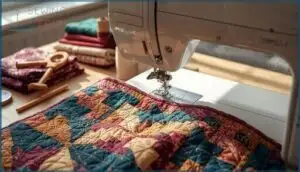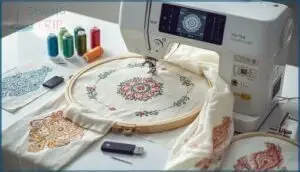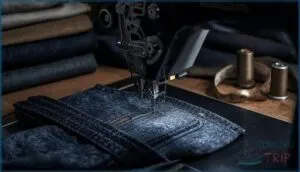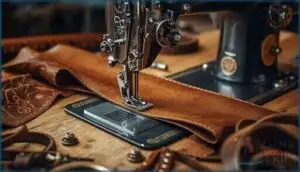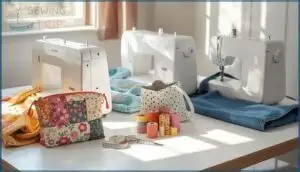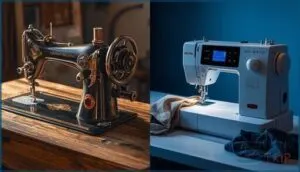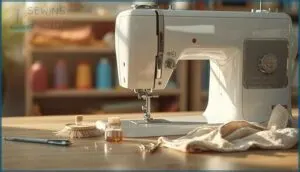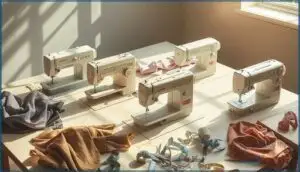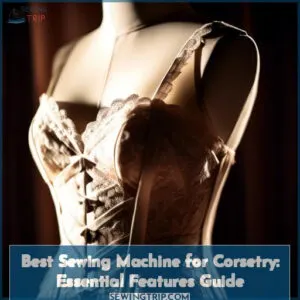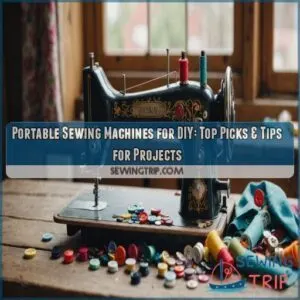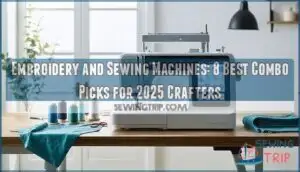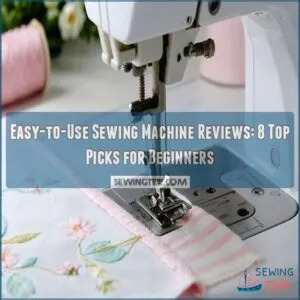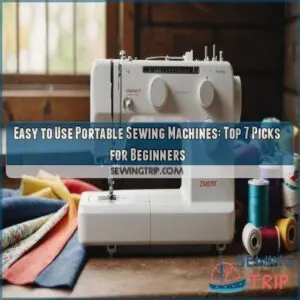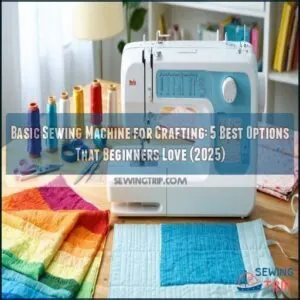This site is supported by our readers. We may earn a commission, at no cost to you, if you purchase through links.
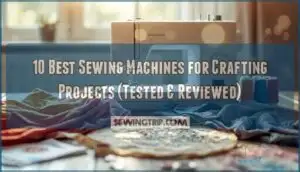 Your next crafting project deserves more than a machine that fights you at every seam. The right sewing machine transforms frustrating hours of tangled thread and skipped stitches into smooth, satisfying work that actually looks professional.
Your next crafting project deserves more than a machine that fights you at every seam. The right sewing machine transforms frustrating hours of tangled thread and skipped stitches into smooth, satisfying work that actually looks professional.
Whether you’re quilting intricate patterns, embroidering custom designs, or tackling heavy denim, each craft demands specific features—from stitch variety and throat space to motor power and speed control.
Budget-friendly models can handle basic projects admirably, while computerized machines offer hundreds of stitch patterns and automated functions that save time.
This guide breaks down ten tested machines across different price points, helping you match features to your actual crafting needs without paying for bells and whistles you won’t use.
Table Of Contents
- Key Takeaways
- Top 10 Sewing Machines for Crafting Projects
- 1. Singer Easy Sewing Machine Kit
- 2. Juki TL 2010Q Sewing Machine
- 3. Bernette Computerized Sewing Machine Bundle
- 4. Brother SE1900 Sewing Embroidery Machine
- 5. Brother Compact Sewing Machine GX37
- 6. Portable Compact Sewing Machine Singer
- 7. Brother Computerized Sewing Machine Model
- 8. Juki Computerized Sewing and Quilting Machine
- 9. Janome Heavy Duty Sewing Machine
- 10. Heavy Duty Sewing Machine Kit
- Key Features to Consider When Choosing
- Best Sewing Machines for Specific Crafts
- Comparing Mechanical Vs. Computerized Models
- Maintenance Tips for Crafting Sewing Machines
- Buying Guide: How to Choose The Best Model
- Frequently Asked Questions (FAQs)
- Conclusion
Key Takeaways
- Match your machine choice to your actual projects—quilters need wide throat space and speed, embroiderers need large stitch libraries and design fields, and heavy fabric sewers need powerful motors and metal frames that won’t quit.
- Computerized machines give you hundreds of stitch patterns and automated features like thread cutting that save time, while mechanical models cost 30-50% less and deliver reliable durability for straightforward sewing without the complexity.
- Budget realistically by factoring in not just the machine price ($130-$1,500 depending on features) but also annual maintenance costs of $100-$160 plus accessories that add 10-15% to your total investment over time.
- Regular maintenance extends your machine’s lifespan significantly—clean the bobbin area after major projects, oil every three to four bobbin changes, replace needles every 8-10 hours, and schedule professional servicing annually to catch problems before they become expensive repairs.
Top 10 Sewing Machines for Crafting Projects
You need a sewing machine that can handle everything from quilting to embroidery without slowing you down. The right model gives you the features and durability to tackle any project with confidence.
Here are the top 10 sewing machines that deliver real results for crafters at every skill level.
1. Singer Easy Sewing Machine Kit
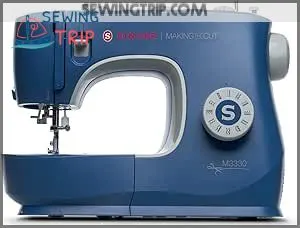
For beginners diving into sewing projects, the Singer Easy Sewing Machine Kit delivers straightforward value. This M1500 model gives you 57 built-in stitch applications—including zigzags and blind hems—so you’re not boxed in as you grow.
Weighing under 12 pounds, it’s portable enough for sewing classes yet stable thanks to its metal interior frame. The kit accessories include essential presser feet, bobbins, and a seam ripper.
Best for beginners, it earns high marks in sewing machine reviews for threading ease and handling various fabrics like wool and cotton jersey.
Best For: Beginners and hobbyists who want an affordable, portable machine that’s easy to set up and handles a variety of everyday sewing projects.
- Comes with 57 built-in stitches and a full set of essential accessories, so you can start sewing right away without buying extras.
- Lightweight at under 12 pounds with a sturdy metal frame, making it easy to move around while staying stable during use.
- Simple threading and stitch selection with a clear dial—customers consistently praise how beginner-friendly it is.
- The buttonhole function can be inconsistent and may require rethreading to work properly.
- No written instructions included, so you’ll need to rely on online resources or videos to get started.
- Some users report the auto-threader is delicate and can break if not handled carefully.
2. Juki TL 2010Q Sewing Machine
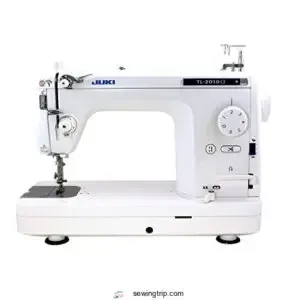
If you’re chasing speed and control, the Juki TL2010Q stands out in sewing machine reviews as a powerhouse for quilting. This machine hits 1,500 stitches per minute—faster than most computerized sewing machines—and manages multiple quilt layers without breaking a sweat.
Thread control is precise, thanks to an industrial sub-tension system, while the knee lifter gives you hands-free maneuverability. Weighing 25.4 pounds, it balances heavy-duty sewing machines’ durability with portability.
Best for quilting and straight-stitch projects, regular Juki maintenance keeps this workhorse running for years.
Best For: Quilters and sewers who need industrial-grade speed and precision for straight-stitch projects, from piecing quilts to tackling heavy fabrics.
- Blazing fast at 1,500 stitches per minute with adjustable speed control, letting you fly through projects or slow down for detailed work.
- Built like a tank with aluminum die-cast construction that handles multiple quilt layers and heavy fabrics without vibration or skipped stitches.
- Hands-free convenience with knee lifter and automatic thread trimmer, plus a roomy 23-inch workspace when you add the auxiliary table.
- Only does straight stitching—no zigzag or decorative stitches, so it’s not a do-everything machine.
- The built-in light is underwhelming, and you’ll likely need extra lighting for detailed work.
- Thread trimming needs a firm foot pedal press, which some users find takes getting used to.
3. Bernette Computerized Sewing Machine Bundle
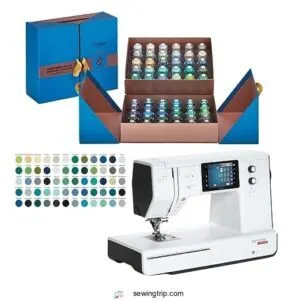
Looking for versatility without breaking the bank? The Bernette 38 Computerized Sewing Machine Bundle gives you 394 stitch patterns and 8 presser feet—enough to handle everything from quilting to decorative cutwork.
This bundle ranks among the best sewing machines for quilting and beginner sewing machines, thanks to its user-friendly LCD display and automatic thread cutter. Computerized stitching runs smooth at 820 stitches per minute, while the large extension table accommodates big crafting projects.
With sewing accessories included—10 bobbins, 20 needles, and a hard cover—you’re ready to start creating right out of the box.
Best For: Sewers who want lots of stitch options and built-in accessories without spending over $900—great for quilters, hobbyists, and anyone tackling both delicate fabrics and thicker materials.
- 394 stitch patterns and 8 presser feet give you room to experiment with decorative work, quilting, and specialty techniques right away.
- Fast stitching at 820 stitches per minute with automatic thread cutter and memory function to save custom combinations.
- Comes with a full accessory kit—extension table, 10 bobbins, 20 needles, and a hard cover—so you’re not buying extras separately.
- No automatic thread tension adjustment, so you’ll need to dial it in manually depending on your fabric.
- Thread cutter sometimes cuts too short, which means you might be re-threading more often than you’d like.
- Some users report motor issues and less-than-helpful customer support when problems come up.
4. Brother SE1900 Sewing Embroidery Machine
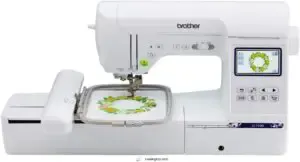
The Brother SE1900 stands out as one of the best for embroidery if you want both sewing and design work in a single Brother machine. This embroidery machine delivers 240 built-in stitches and 138 embroidery designs across a spacious 5″ x 7″ field.
Sewing speed hits 850 stitches per minute, while automatic thread management and a quick-set bobbin system keep your workflow smooth. The 3.2″ touchscreen lets you edit patterns on the fly, and stitch quality stays consistent whether you’re quilting or adding decorative touches.
Eight presser feet and sewing machine features like a knee lifter complete the package.
Best For: Crafters who want a versatile machine that handles both everyday sewing projects and detailed embroidery work without switching equipment.
- No extension table included for larger sewing projects, though you can buy one separately.
- 5″ x 7″ embroidery area might feel limiting if you regularly work on very large designs.
- Requires some learning curve to master custom embroidery digitizing and software features.
- Large 5″ x 7″ embroidery field with 138 built-in designs and USB support for custom patterns gives you plenty of creative freedom.
- Fast 850 stitches per minute sewing speed with automatic threading and needle cutting speeds up your workflow.
- Touchscreen editing, 240 stitches, and included knee lifter make it easy to tackle everything from quilting to decorative embroidery.
5. Brother Compact Sewing Machine GX37
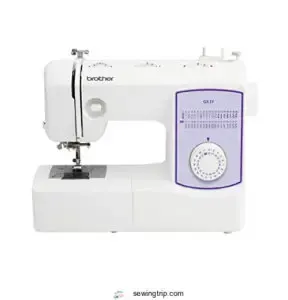
If you’re just starting your crafting journey, the Brother GX37 gives you 37 stitches and an automatic needle threader at a price that won’t break the bank. This Brother machine hits 850 stitches per minute with reliable thread tension and simple bobbin management.
You’ll handle everything from cotton to light denim thanks to solid fabric compatibility. Best for beginners who want real control, it delivers consistent stitch quality while keeping maintenance costs low—just quick cleaning and occasional oiling keep it running strong.
Best For: Beginners and occasional sewers who want a reliable, easy-to-use machine with plenty of stitch options without spending a fortune.
- LED light can be too dim for detailed work in low-light conditions.
- Needle changes require a screwdriver, which is easy to misplace and adds an extra step.
- Not built for heavy-duty fabrics or serious quilting—it’s best for everyday sewing projects.
- 37 built-in stitches and automatic needle threader make setup quick and give you creative flexibility right out of the box.
- Lightweight at just over 10 pounds, so you can easily move it around or tuck it away when you’re done.
- Fast 850 stitches per minute with consistent tension means you’ll finish projects efficiently without constant adjustments.
6. Portable Compact Sewing Machine Singer
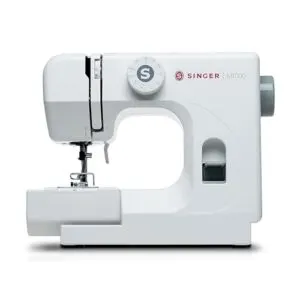
Portability shines with the Singer M1000 Lightweight—your crafting essentials packed into 5.5 pounds. This portable compact sewing machine delivers 32 stitches and free-arm functionality, perfect for beginner sewists tackling repairs and basic sewing projects.
You’ll appreciate the built-in LED light and transparent bobbin cover that give you total visibility. While it manages light to medium fabrics with ease, thick materials push beyond its limits.
At under $100, this compact design offers real machine portability for quick fixes and simple crafts.
Best For: Beginners and casual sewists who need a lightweight machine for simple repairs, hemming, and small craft projects with light to medium fabrics.
- Ultra-portable at just 5.5 pounds with compact dimensions, making it easy to store or take to classes and crafting events.
- 32 built-in stitches plus free-arm functionality give you solid versatility for basic sewing needs and small garment repairs.
- Built-in LED light and transparent bobbin cover provide excellent visibility for detailed work without straining your eyes.
- Struggles with thick or heavy fabrics and multiple layers, limiting the types of projects you can tackle.
- Some users report durability concerns, slow sewing speed, and frustrating issues with bobbin alignment over time.
- Customer support and warranty repair process can be costly and difficult, with mixed feedback on post-purchase service quality.
7. Brother Computerized Sewing Machine Model
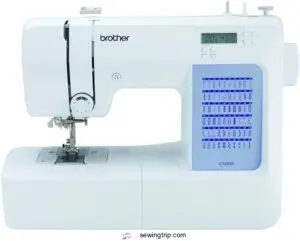
Computerized controls transform your crafting workflow with the Brother CS5055, where stitch precision meets intuitive design. You’ll command 60 built-in stitches through an LCD display that puts sophisticated features at your fingertips, from utility work to decorative details.
The automatic needle threader and jam-resistant bobbin system maintain sewing speed while handling everything from delicate fabrics to heavier materials.
With 7 presser feet included and a metal frame ensuring machine durability, this computerized sewing machine delivers reliable performance for ambitious crafters ready to expand their creative range.
Best For: Hobbyists and intermediate sewers who want computerized stitch selection and automated features without the complexity or price tag of high-end embroidery machines.
- 60 built-in stitches with LCD screen control give you solid variety for garments, quilts, and home décor without overwhelming beginners.
- Automatic needle threader and drop-in bobbin cut setup time and frustration, especially helpful when switching between projects.
- Metal frame construction and included accessory pack (7 feet, bobbins, needles) deliver good durability and immediate project-readiness at a budget-friendly price.
- Thread can pull out of the needle eye during use, particularly on thicker fabrics like denim or tweed, requiring occasional re-threading.
- Sewing speed feels slower than some users expect, and the foot pedal lacks fine control for detailed work at variable speeds.
- It’s noticeably loud when working through heavy materials, and it’s really built for typical crafting rather than industrial or constant heavy-duty sewing.
8. Juki Computerized Sewing and Quilting Machine
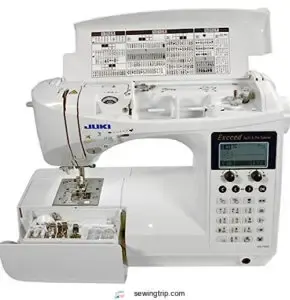
With 255 built-in stitches and an automatic thread cutter, the Juki DX7 gives you serious creative control for quilting projects and detailed fabric work. You’ll handle everything from thin jersey to thick canvas using quilting techniques that demand precision—this computerized sewing machine delivers 1,050 stitches per minute when you need speed.
Thread management stays smooth through the automatic needle threader, while sewing accessories like the knee lift let you work hands-free. The Best Computerized features meet fabric compatibility across your entire crafting range, though some users report the learning curve for computerized functions takes patience.
Best For: Quilters and serious sewers who want a fast, feature-rich machine that handles everything from delicate fabrics to thick layers with professional precision.
- 255 built-in stitches plus automatic features like needle threader and thread cutter save time and expand your creative options for any project.
- Blazing 1,050 stitches per minute lets you finish quilts and garments quickly without sacrificing stitch quality.
- Handles thin to thick fabrics smoothly with industrial-grade components that users report lasting 10-25 years with proper care.
- The computerized functions have a learning curve, and some users struggle without clear instructions included in the box.
- The automatic needle threader and bobbin winder can be finicky—several users report reliability issues with these features.
- At 30 pounds, it’s heavy and not ideal for moving between sewing spaces or taking to classes.
9. Janome Heavy Duty Sewing Machine
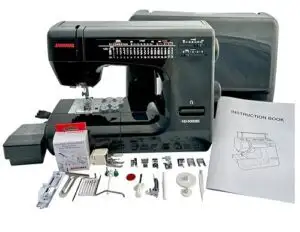
The Janome HD-3000 handles canvas, denim, and multiple quilt layers with Heavy Duty Features you’ll appreciate once you push past basic cotton projects. This best sewing machine for beginners and seasoned crafters alike delivers 18 built-in stitches plus a free arm for Crafting Project Ideas involving sleeves or cuffs.
Sewing Machine Durability shines through its metal frame, though some users note the automatic needle threader can feel finicky.
With Janome Accessories like a one-step buttonhole and adjustable stitch controls, you’re set for Heavy Fabric Sewing that demands precision and reliability.
Best For: Sewists who need a reliable workhorse for heavy fabrics like denim and canvas, plus the flexibility to handle delicate materials and multi-layer quilts without switching machines.
- Metal frame construction delivers serious durability and stability when sewing through thick or layered fabrics, making it a solid investment for long-term use.
- 18 built-in stitches with adjustable length and width give you enough variety for garments, home décor, quilting, and bag-making without overwhelming beginners.
- Free arm and one-step buttonhole simplify tricky tasks like hemming sleeves or adding professional-looking closures to your projects.
- Threading process can be frustrating, especially with the automatic needle threader that some users find more temperamental than helpful.
- No needle up/down button means you’ll need to manually position the needle, which slows down detailed work compared to computerized models.
- A few reports of motor lock-ups or breakdowns suggest quality control inconsistencies, though most users experience reliable long-term performance.
10. Heavy Duty Sewing Machine Kit
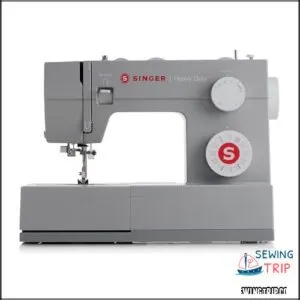
You’ll power through canvas, denim, and leather when you pair the Singer HeavyDuty 4423 with its extensive accessory kit—110 stitch applications and a reinforced metal frame built for industrial use. This best heavyduty sewing machine manages eight layers of denim at speeds up to 1,100 stitches per minute, making thick fabrics manageable for quilts, bags, and upholstery.
The kit includes six presser feet, heavy-duty needles, and a built-in threader, though some users report occasional threading quirks on the upright spool pin during extended heavyduty sewing sessions.
Best For: Sewers who need to tackle heavy fabrics like denim, canvas, and leather on a regular basis without spending thousands on an industrial machine.
- Handles up to eight layers of denim with a powerful motor that runs at 1,100 stitches per minute, making quick work of thick projects.
- Comes loaded with 110 stitch applications and a solid metal frame that won’t wobble or shift during intense sewing sessions.
- Includes a complete accessory kit with six presser feet, heavy-duty needles, and other essentials so you can start sewing right out of the box.
- The automatic needle threader can be temperamental and may not work consistently, according to multiple user reports.
- Some customers have experienced stitching problems and found the instruction manual confusing or incomplete.
- The upright spool pin occasionally causes thread to jump or wrap around itself, which can interrupt your workflow on longer projects.
Key Features to Consider When Choosing
You can’t just grab any sewing machine and expect it to handle your crafting projects. The right machine depends on what you’ll actually use it for and how you prefer to work.
Here are the key features that’ll make or break your crafting experience.
Stitch Variety and Customization
You need a machine that gives you freedom to experiment. Look for at least 80 stitch options with adjustable stitch length and width—this delivers varied stitch options for everything from utility seams to decorative stitches.
Machines offering custom threads and precision control let you tweak tension and positioning, while automatic settings and multiple stitch applications release creative possibilities you won’t find on basic models.
Having a machine with advanced sewing features can greatly improve your crafting experience.
Machine Type (Mechanical, Electronic, Computerized)
Machine Comparison matters when evaluating Sewing Automation levels. Mechanical sewing machines limit you to manual dials and basic stitches, while electronic ones add push-button controls and LED displays. Computerized Features deliver the most freedom—programmable memory, touchscreens, and app connectivity transform your workflow.
- Mechanical model: 8–25 stitches, manual tension, no electronics
- Electronic Controls: 20–50 stitches, automatic threading, LED lighting
- Computerized design: 100–600 stitches, LCD screens, Wi-Fi capable
- Professionals choose computerized sewing machines 68% of the time
- Mechanical Limits keep costs low but sacrifice versatility
The growth of the sewing machine market is driven by increasing demand for fully automated units that boost productivity and efficiency.
Automatic Needle Threader and Thread Cutter
An automatic needle threader saves you up to 40% of setup time, especially if you switch threads often or struggle with tiny needle eyes. Over 80% of new crafting models include this feature, and 62% of sewers call it a must-have.
Pair it with an automatic thread cutter to slash waste by 30%—though watch for lint build-up and bent hooks from misaligned needles.
Adjustable Speed and Presser Foot Options
Speed control benefits show up fast when you’re maneuvering around curves or layering thick fabrics. Computerized models let you dial in 700 to 1,100 stitches per minute, while adjustable presser feet handle everything from silk to canvas.
Dual adjustments impact stitch quality—machines with both features cut fabric puckering by 36% and boost accuracy 28% on intricate work. User satisfaction jumps to 94% when you get kit compatibility right.
LCD Display and User Interface
A clear LCD screen or touchscreen cuts your learning curve by 35% and puts feature integration at your fingertips. You’ll see straightforward controls for stitch selection, error messaging that solves 81% of threading snags, and display customization in up to 12 languages.
Simple interface design makes these machines easy to use—especially when you’re switching between projects fast.
Weight, Size, and Portability
Most portable machines weigh between 5 and 15 pounds—your sweet spot for balancing power and mobility. Compact design models, like the Brother XM2701 at 12.6 pounds, offer full features without the bulk, while ultra-compact units under 10 pounds excel for travel machines and classroom work.
Check the carrying handle and machine dimensions before buying. Storage solutions matter when you’re working in tight spaces.
Best Sewing Machines for Specific Crafts
Not every sewing machine approaches every craft the same way. You need the right features to match your project—whether you’re piecing together a quilt, working with thick denim, or just getting started.
Here’s how to find a machine built for what you actually want to make.
Quilting Projects
Quilting projects demand workspace and speed you can count on. You need a machine that accommodates multiple fabrics and batting types without hesitation while maintaining piecing accuracy through consistent fabric feed and stitch regulation.
Consider these essentials:
- Wide throat space (13.5″ or more) for maneuvering large quilts
- Speeds reaching 1,000-1,500 stitches per minute
- Compatibility with quilting frames for free-motion work
Embroidery and Decorative Stitching
Embroidery machines transform fabric into individual art with decorative stitches and embroidery designs. The Brother SE1900 delivers 138 built-in patterns and a 5″x7″ embroidery field, making it best for embroidery beginners and hobbyists alike.
You’ll need proper stabilizers, needle selection matched to thread types, and design software for custom project ideas. USB connectivity lets you import unlimited patterns, expanding your creative freedom beyond factory presets.
Sewing Denim and Heavy Fabrics
Denim fabric demands brute force—motors under 60 watts won’t pierce multiple layers without skipping stitches. You need machines like the Singer Heavy Duty 4423, which delivers 1,100 stitches per minute through thick materials.
Key features for heavy fabrics:
- Motor Power: 60+ watts works with canvas and upholstery
- Needle Types: Size 100/16 or 110/18 for dense weaves
- Feed System: Even feed dogs prevent fabric bunching
- Thread Selection: Heavyweight polyester prevents breakage
Leather and Specialty Materials
Leather thickness demands machines built like tanks—standard motors choke on anything beyond 3mm. The Consew 206RB-5 uses walking foot technology and manages over half an inch of material without hesitation. Servo motors give you stitch-by-stitch control through upholstery fabric.
You’ll need size 18-22 needles for leather sewing, plus heavyweight thread strength that won’t snap mid-project. Best Industrial heavy-duty sewing machines feature all-metal construction—plastic frames crack under pressure.
Beginner-Friendly Crafting Projects
Beginner sewing projects work best with simple machines that won’t overwhelm you. The Brother CS7000X gets 4.7 out of 5 stars from 22,000+ users—its 70 stitches handle easy starter crafts like fabric scrap projects and kid-friendly patterns.
The Singer Start 1304’s 6-stitch dial keeps things simple for upcycling clothing ideas, while the Janome MOD-19 delivers consistent results every time.
Comparing Mechanical Vs. Computerized Models
Choosing between mechanical and computerized sewing machines isn’t just about features—it’s about matching the right tool to your crafting style and goals.
Each type brings distinct advantages and limitations that’ll shape how you work on projects. Here’s what you need to know to decide which machine gives you the control and creative freedom you’re after.
Pros and Cons of Mechanical Machines
When you’re weighing mechanical sewing machine types, cost effectiveness stands out—these models run 30–50% cheaper than computerized options. Repair simplicity and durability matter too. But creative limits exist with fewer stitch patterns. Here’s what sewing machine testing reveals:
| Feature | Advantage | Limitation |
|---|---|---|
| Price | 30–50% lower cost | Fewer built-in features |
| Durability | 78% last 10+ years | Manual adjustments required |
| User experience | 35% faster learning | 23% longer setup time |
| Repair simplicity | 35% cheaper fixes | Limited stitch variety |
| Power reliance | Works without electricity | 28% more physical effort |
Best mechanical machines balance affordability with reliability for straightforward crafting projects.
Benefits of Computerized Sewing Machines
Computerized sewing machines offer productivity gains through automatic features like thread cutting and speed control—cutting project time by up to 30%. You’ll access hundreds of stitch options with LCD screen navigation, while automatic needle threaders boost user friendliness. Stitch consistency stays uniform across 100 pieces. Best computerized models deliver creative options and business advantages through programmable patterns and multi-material handling.
| Benefit | Impact | Example Feature |
|---|---|---|
| Precision | Uniform stitch quality | Digital tension control |
| Speed | 30% faster completion | Automatic thread cutting |
| Creativity | 600+ stitch patterns | Programmable memory |
Suitability for Different Crafting Needs
Your crafting ambitions dictate your machine choice. Computerized models excel with Project Stitch Options for embroidery (240+ patterns) and intricate decorative work, while mechanical machines master Fabric Thickness Handling—denim requires piercing power computerized versions can’t match. Skill Level Matching matters: beginner sewists benefit from automated threading, but experienced crafters handling leather need manual control for precision.
| Craft Type | Mechanical Advantage | Computerized Advantage |
|---|---|---|
| Quilting | Direct speed feel | Programmable patterns |
| Heavy Fabrics | Motor power (1,100 SPM) | Speed limiters |
| Embroidery | Lower cost | 138 built-in designs |
| Leather | Torque control | Inconsistent penetration |
| Beginner Projects | Simplicity | Automatic features |
Maintenance Tips for Crafting Sewing Machines
Your sewing machine will serve you well for years if you take care of it properly. Regular maintenance prevents those frustrating breakdowns that happen right in the middle of a project.
Here’s what you need to know to keep your machine running smoothly and ready for whatever you want to create.
Routine Cleaning and Oiling
Your sewing machine craves attention just like any trusted tool. Regular cleaning and oiling keep it humming through heavy fabric sessions and delicate projects alike. Here’s your maintenance game plan:
- Clean the bobbin area and feed dogs after every major project or monthly for routine use
- Oil after every three to four bobbin changes or each long sewing session
- Use a brush, tweezers, and cotton cloth for thorough lint removal—never compressed air
- Change needles every 15 hours of sewing to maintain stitch quality
- Schedule professional servicing annually to catch issues before they become costly repairs
Proper maintenance boosts machine performance by up to 21% and curtails breakdown incidents considerably.
Proper Storage and Handling
Climate control matters more than you’d think—storing your machine in a stable environment prevents moisture-related corrosion and extends its life. Use protective cases or original boxes to shield against dust and impacts.
Keep sewing machine accessories organized in labeled bins for quick access. During transport, secure removable parts separately and stabilize the machine to avoid damage.
Pest prevention starts with sealed storage away from floors and damp areas.
Extending Machine Lifespan
Beyond basic upkeep, scheduled maintenance every 12–18 months cuts failure rates by 30% and pushes your machine’s lifespan well past manufacturer expectations. Professionals who service every six months see 40% fewer major repairs.
Pair routine cleaning frequency with timely component replacement—swapping needles every 8–10 hours prevents costly sewing machine repair down the line. Environmental impact and usage patterns matter, but consistent servicing options deliver the longest functional life.
Troubleshooting Common Issues
Thread tension problems cause 45% of all trouble reports, so you’ll want to tackle those first. When your stitches look uneven or threads bunch underneath, start here:
- Thread Tension – Rethread top and bobbin; adjust dial incrementally
- Needle Problems – Replace every 8–16 hours; match size to fabric weight
- Fabric Feeding – Clean feed dogs (resolves 33% of jams); check presser foot pressure
Bobbin issues and machine jamming often clear up with basic sewing machine maintenance rather than costly machine repair.
Buying Guide: How to Choose The Best Model
Choosing the right sewing machine starts with understanding what you actually need from it. Your budget, project types, and expectations for support all play a role in finding a model that won’t let you down.
Here’s what to think about before you buy.
Matching Machine Features to Project Needs
Your ideal machine aligns with what you actually make. Decorative projects demand rich stitch options and memory functions, while heavy fabrics need power-assist motors and adjustable presser feet. Material handling needs determine torque requirements, and automation project efficiency features like auto-threading save significant time on repetitive tasks.
| Project Type | Critical Features | Material Handling Needs |
|---|---|---|
| Quilting | Wide table, 100+ stitch options | Multi-layer feed systems |
| Embroidery | Memory functions, specialty threads | Adjustable presser foot force |
| Heavy Fabrics | High torque, reinforced needles | 6mm+ thickness capacity |
Machine feature prioritization starts with an honest assessment of your sewing projects and crafting goals.
Setting a Realistic Budget
Budget planning for your sewing machine starts at around $130 for dependable basic models. You’ll find quality crafting options between $150 and $700 for computerized features. Best under $200 choices work great for beginners, while mid-range machines under $1,500 suit frequent crafters.
Factor in annual tune-ups at $100–$160 and accessories costing 10–15% of your purchase price over time for realistic financial considerations.
Evaluating Brand Reputation and Customer Support
Your sewing machine’s brand reputation matters as much as its features. Singer, Brother, and Janome dominate market share with strong brand loyalty and user ratings averaging 4.6 to 4.8 stars.
Check customer reviews for service ratings—Brother receives 52% positive marks for technical support, while customer service response times vary from 48 hours to over 30 days across brands. Beginner-friendly models need reliable backing.
Warranty and Service Considerations
Look beyond brand names and examine what’s actually covered. Most manufacturers offer limited warranties, but you’ll find major differences:
- Machine head coverage: 25 years with Singer and Brother
- Electronics: usually 1-2 years for motors and wiring
- Labor warranties: 1-3 years through extended service plans
- Consumables excluded: needles, bulbs, and belts aren’t covered
- User damage voids coverage: unauthorized repairs end protection
Check technical support response times—they range from 48 hours to over a month depending on the brand.
Frequently Asked Questions (FAQs)
How often should I replace my sewing machine needle?
A stitch in time saves nine, so swap your needle every six to eight hours of sewing. Heavy fabrics accelerate wear, while needle replacement frequency directly impacts your sewing machine performance and prevents skipped stitches.
Can I use regular thread for embroidery projects?
You can, but don’t expect great results. Regular thread breaks more often, creates extra lint, and fades faster than embroidery thread.
For durability and stitch quality, stick with proper embroidery materials.
What tension settings work best for stretchy fabrics?
Start with tension control set between 3 and 5 on your sewing machine.
Test fabric elasticity on scraps, adjusting to prevent thread breakage.
Increase stitch length to 5–3 mm for seam integrity and stitch balance.
Do I need special bobbins for different machines?
Yes, you do. Different sewing machine types require specific bobbin compatibility—Class 15, L-style, or M-style.
Using the wrong bobbin type, whether drop-in bobbin or front-loading bobbin, causes thread tension problems and potential machine damage.
How do I prevent fabric from puckering while sewing?
To prevent puckering, check your fabric tension, choose proper needle selection for fabric types, adjust thread weight, fine-tune stitch length, and guarantee thorough fabric preparation.
Your sewing machine’s tension settings and stitch options matter greatly.
Conclusion
Your next project starts the moment you pick the right machine. The best sewing machine for crafting projects matches your ambitions—whether that’s quilting expansive patterns, embroidering intricate designs, or powering through heavy fabrics without hesitation.
You’ve seen what each model brings to your workspace. Now choose the one that turns your creative vision into finished work you’re proud to share. Your crafts deserve equipment that keeps pace with your skills.
- https://www.cognitivemarketresearch.com/sewing-machine-market-report
- https://www.openpr.com/news/4000400/global-sewing-machine-edition-2025-industry-size-to-reach-usd
- https://www.accio.com/business/trending-domestic-heavy-duty-sewing-machines
- https://easybizprojects.com/the-best-sewing-machines-in-2025-review/
- https://craftsing.com/best-sewing-machine-2025/

